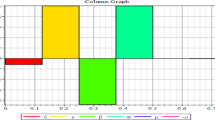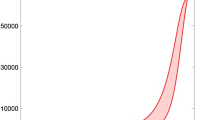Abstract
In this chapter, a fractional SEIR model and its robust first-order unconditionally convergent numerical method is proposed. Initial conditions based on Namibian data as of 4 July 2020 were used to simulate two scenarios. In the first scenario, it is assumed that the proper control mechanisms for kerbing the spread of COVID-19 are in place. In the second scenario, a worst-case scenario is presented. The worst case is characterised by ineffective COVID-19 control mechanisms. Results indicate that if proper control mechanisms are followed, Namibia can contain the spread of COVID-19 in the country to a lowest level of 1, 800 positive cases by October 2020. However, if no proper control mechanisms are followed, Namibia can hit a potentially unmanageable level of over 14, 000 positive cases by October 2020. From a mathematical point of view, results indicate that the fractional SEIR model and the proposed method are appropriate for modelling the chaotic nature observed in the spread of COVID-19. Results herein are fundamentally important to policy and decision-makers in devising appropriate control and management strategies for curbing further spread of COVID-19 in Namibia.
Access this chapter
Tax calculation will be finalised at checkout
Purchases are for personal use only
Similar content being viewed by others
References
Djilali, S., & Ghanbari, B. (2020). Coronavirus pandemic: A predictive analysis of the peak outbreak epidemic in South Africa. Turkey, and Brazil, Chaos, Solitons & Fractals, 138, 109971.
Mishra, A. M., Purohit, S. D., Owolabi, K. M., & Sharma, Y. D. (2020). A nonlinear epidemiological model considering asymptotic and quarantine classes for SARS CoV-2 Virus. Chaos, Solitons & Fractals, 138, 109953.
Hu, Y., Sun, J., Dai, Z., Deng, H., Li, X., Huang, Q., et al. (2020). Prevalence and severity of corona virus disease 2019 (COVID-19): A systematic review and meta-analysis. Journal of Clinical Virology, 127, 104371.
Postnikov, E. B. (2020). Estimation of COVID-19 dynamics “on a back-of-envelope”: Does the simplest SIR model provide quantitative parameters and predictions? Chaos. Solitons & Fractals, 135, 109841.
Manotosh, M., Soovoojeet, J., Swapan, K. N., Anupam, K., Sayani, A., & Kar, T. K. (2020). A model based study on the dynamics of COVID-19: Prediction and control. Chaos, Solitons & Fractals, 136, 109889.
Kassa, S. M., Njagarah, J. B. H., & Terefe, Y. A. (2020). Analysis of the mitigation strategies for COVID-19: From mathematical modelling perspective. Chaos, Solitons & Fractals, 138, 109968.
Fanelli, D., & Piazza, F. (2020). Analysis and forecast of COVID-19 spreading in China. Italy and France, Chaos, Solitons & Fractals, 134, 109761.
Ullah, S., & Khan, M. A. (2020). Modeling the impact of non-pharmaceutical interventions on the dynamics of novel coronavirus with optimal control analysis with a case study, Chaos. Solitons & Fractals, 139, 110075. https://doi.org/10.1016/j.chaos.2020.110075.
Barmparis, G. D., & Tsironis, G. P. (2020). Estimating the infection horizon of COVID-19 in eight countries with a data-driven approach. Chaos, Solitons & Fractals, 135, 109842.
Willis, M. J., Díaz, V. H. G., Prado-Rubio, O. A., & von Stosch, M. (2020). Insights into the dynamics and control of COVID-19 infection rates, Chaos. Solitons & Fractals, 138, 109937.
Amina, R., Shah, K., Asifa, M., Khana, I., & Ullaha, F. (2020). An efficient algorithm for numerical solution of fractional integro-differential equations via Haar wavelet. Journal of Computational and Applied Mathematics, 381, 113028.
Alzaid, S. S., & Alkahtani, B. S. T. (2019). Modified numerical methods for fractional differential equations. Alexandria Engineering Journal, 58, 1439–1447.
Al-Zhour, Z., Al-Mutairi, N., Alrawajeh, F., & Alkhasawneh, R. (2019). Series solutions for the Laguerre and Lane-Emden fractional differential equations in the sense of conformable fractional derivative. Alexandria Engineering Journal, 58, 1413–1420.
Das, S. (2008). Functional Fractional Calculus for System Identification and Controls. Berlin, Heidelberg: Springer-Verlag.
Alkahtani, B. S. T., & Alzaid, S. S. (2020). A novel mathematics model of covid-19 with fractional derivative. Stability and Numerical Analysis, Chaos, Solitons & Fractals, 138, 110006.
Atangana, A. (2020). Modelling the spread of COVID-19 with new fractal-fractional operators: Can the lockdown save mankind before vaccination. Chaos, Solitons & Fractals, 136, 3109860.
Nuugulu, S.M., Gideon, F. & Patidar, K. C. (2020). A robust \(\theta \)-method for a time-space-fractional black-scholes equation, Springer Proceedings, Article in Press.
Nuugulu, S. M., Gideon, F., & Patidar, K. C. (2020). An efficient finite difference approximation for a time-fractional black-scholes PDE arising via fractal market hpothesis. Under Review: Alexandria Engineering Journal.
Owolabi, K. M. (2019). Mathematical modelling and analysis of love dynamics: A fractional approach. Physica A, 525, 849–865.
Prakash, A., & Kaur, H. (2019). Analysis and numerical simulation of fractional order Cahn-Allen model with Atangana-Baleanu derivative. Chaos, Solitons & Fractals, 124, 134–142.
Nuugulu, S. M., Gideon, F., & Patidar, K. C. (2020). An efficient numerical method for pricing double barrier options on an underlying asset following a fractal stochastic process. Under Review: Applied and Computational Mathematics.
Nuugulu, S. M., Gideon, F., & Patidar, K. C. (2020). A robust numerical scheme for a time fractional Black-Scholes partial differential equation describing stock exchange dynamics, Chaos. Solitons & Fractals: Article In Press.
Julius, E. T., Nuugulu, S. M., & Julius L. H. (2020). Estimating the economic impact of Covid-19: a case study of Namibia, MPRA (preprint) https://mpra.ub.uni-muenchen.de/99641/.
Khan, M. A., & Atangana, A. (2020). Modeling the dynamics of novel coronavirus (2019-nCov) with fractional derivative. Alexandria Engineering Journal, 59, 2379–2389. https://doi.org/10.1016/j.aej.2020.02.033.
Zhang, Y., Yu, X., Sun, H., Tick, G. R., Wei, W., & Jin, B. (2020). Applicability of time fractional derivative models for simulating the dynamics and mitigation scenarios of COVID-19. Chaos, Solitons & Fractals, 138, 109959.
Khan, M. A., Atangana, A., Alzahrani, E., & Fatmawati, E. (2020). The dynamics of COVID-19 with quarantined and isolation. Advances in Difference Equations, 1, 425. https://doi.org/10.1186/s13662-020-02882-9.
Diethelm, K., & Ford, N. J. (2002). Analysis of fractional differential equations. Journal of Mathematical Analysis and Applications, 265, 229–248.
Li, M. Y., & Wang, L. (2020). Global stability in some seir epidemic models. The IMA Volumes in Mathematics and its Applications126. (2002) (Springer, New York)
Acknowledgements
The authors would like to thank the two anonymous reviewers whose comments and suggestions helped improve this chapter.
Author information
Authors and Affiliations
Corresponding author
Editor information
Editors and Affiliations
Rights and permissions
Copyright information
© 2021 The Author(s), under exclusive license to Springer Nature Singapore Pte Ltd.
About this paper
Cite this paper
Nuugulu, S.M., Shikongo, A., Elago, D., Salom, A.T., Owolabi, K.M. (2021). Fractional SEIR Model for Modelling the Spread of COVID-19 in Namibia. In: Shah, N.H., Mittal, M. (eds) Mathematical Analysis for Transmission of COVID-19. Mathematical Engineering. Springer, Singapore. https://doi.org/10.1007/978-981-33-6264-2_9
Download citation
DOI: https://doi.org/10.1007/978-981-33-6264-2_9
Published:
Publisher Name: Springer, Singapore
Print ISBN: 978-981-33-6263-5
Online ISBN: 978-981-33-6264-2
eBook Packages: EngineeringEngineering (R0)




